- News
- Reviews
- Bikes
- Components
- Bar tape & grips
- Bottom brackets
- Brake & gear cables
- Brake & STI levers
- Brake pads & spares
- Brakes
- Cassettes & freewheels
- Chains
- Chainsets & chainrings
- Derailleurs - front
- Derailleurs - rear
- Forks
- Gear levers & shifters
- Groupsets
- Handlebars & extensions
- Headsets
- Hubs
- Inner tubes
- Pedals
- Quick releases & skewers
- Saddles
- Seatposts
- Stems
- Wheels
- Tyres
- Tubeless valves
- Accessories
- Accessories - misc
- Computer mounts
- Bags
- Bar ends
- Bike bags & cases
- Bottle cages
- Bottles
- Cameras
- Car racks
- Child seats
- Computers
- Glasses
- GPS units
- Helmets
- Lights - front
- Lights - rear
- Lights - sets
- Locks
- Mirrors
- Mudguards
- Racks
- Pumps & CO2 inflators
- Puncture kits
- Reflectives
- Smart watches
- Stands and racks
- Trailers
- Clothing
- Health, fitness and nutrition
- Tools and workshop
- Miscellaneous
- Buyers Guides
- Features
- Forum
- Recommends
- Podcast
TECH NEWS
Cannondale Synapse 2018 First Ride - has Cannondale made the best endurance bike yet?
It hardly seems like four years ago that I was in Tuscany riding the then all-new Cannondale Synapse, but time flies in the road bike industry and so a few weeks ago I found myself once again in Italy, this time the equally beautiful Lake Como, to put the revamped 2018 Synapse through its paces.
The Synapse needs no introduction. It’s a bike that has proven to be very popular for the US company in the increasingly popular endurance class, winning many fans and plaudits; it won road.cc's bike of the year award a few years ago. The endurance category to which the Synapse belongs is maturing nicely with ever increasing and advanced options, and some interesting solutions being developed by some companies in an attempt to offer more of the key selling point of these bikes, namely comfort.
- 19 of the best 2017 sportive bike
You can read all the tech details about the new Synapse here, and there's a revealing interview with the designers behind the new bike that you can read here. A quick recap though, the new Synapse is 200g lighter, stiffer, more comfortable, takes 32mm tyres and has mudguard eyelets, only comes with disc brakes and features a new SAVE Systembar handlebar. With that out of the way, let's deal with the important stuff, like how it rides.
While some brands have gone down the route of adding suspension, Cannondale has instead opted to refine its SAVE micro suspension concept and focused on reducing the overall frame and fork weight, as well as adding more stiffness. Cannondale is gambling that cyclists shopping for a bike in this category will want comfort but not at the expense of performance and liked the simplicity and looks of the previous Synapse. It’s a gamble that might have just paid off. Two days riding around the very scenic and picturesque Lake Como is not enough to fully get under the skin of the new bike and make a thorough assessment - that’ll wait until we get a test bike here in the UK - but it was abundantly clear that the decision to build on the solid foundations of the previous Synapse and enhance its strengths and smooth out its weaknesses has resulted in a fast, comfortable and dynamic handling endurance bike, yet with the familiarity of the old bike that won many fans.
Before I go on, I have an admission to make. As much as I’ve always liked the Synapse, I’ve actually always favoured the SuperSix Evo (I’ve had one since 2012) because I felt it better suited my racing aspirations. I love its handling and its comfort, impressive considering the racing focus. But as someone who doesn’t really race that much anymore and isn’t exactly getting any younger, the Synapse is, on paper at least, the bike that suits my riding better. With the changes to the new Synapse, it might just be time to retire the SuperSix Evo. Why? Well, the new Synapse is faster, stiffer, more agile and responsive, wrapped up with a geometry that lets you get a reasonably low position if you want it, yet has the silky smoothness to not batter you into submission on a long ride. There's little concern that performance has been sacrificed for comfort with the new Synapse. And there's room for mudguards for winter grinding, a practicality you really only fully appreciate with the passing of years...
Comfort in a bike comes down to two factors, the geometry and the position is provides, and the ability of the bike to smooth rough roads. With the Synapse, the comfort factor has definitely been dialled up several notches. There’s noticeably more seated comfort and you can feel the saddle moving backwards when you hit a sizeable hole or bump in the road, thanks to the newly designed seatpost that retains the same skinny 25.4mm diameter of the previous bike. The Fabric Scoop saddle that Cannondale specs on the new bike is a good choice, with the shape, padding and base flex all contributing to the comfort.
More noticeable is the front end comfort. While I couldn’t detect the new Systembar handlebar actually deflecting up to the 6mm that Cannondale says it can during the limited time on the bike, it was noticeable that the front of the bike was transmitting fewer vibrations to the hands and arms. I’m not normally a fan of one-piece handlebars because I typically find the aero shaped top section too wide to grip, and the fixed nature of the design limits fit adjustments. The Systembar, however, has slender shaped tops that my fingers easily wrap around and are a comfortable place to rest your hands, and the stem can be swapped for a longer or shorter one as your fit requirements dictate. I'm not sure the Garmin mount on top of the handlebar is the most attractive solution, however.
So yes the new Synapse appears to offer extra comfort and smoothness over the old model. It is not however in the same league as the Specialized Roubaix which with its Future Shock providing 20mm of suspension really does iron out bumps at the front. Seated comfort, however, is on a par with the Canyon Endurace CF SLX and not that far behind the new Trek Domane with its new adjustable Isospeed decoupler, or the Roubaix with its lowered seatclamp and large seat tube around narrow seatpost design. The market is splitting, with brands like Cannondale, Giant, Merida opting for optimised tube shapes and carbon fibre layup, while Trek and Specialized have gone down the road of engineering suspension solutions. It means more choice for consumers with bikes catering for different needs and tastes.
Bigger tyres play a big part in adding more isolation from rough roads. The new Synapse takes up to 32mm measured tyres and the 28mm Vittoria tyres at about 65-70psi provided a nice cushioning ride that helps the bike to float along rough roads. It was my first ride on these tyres and I was impressed, they appear to roll along efficiently and have a supple feel with plenty of grip to exploit in the corners. I’ll be requesting some of these for a separate review for sure.
Where the Synapse really shines is when you increase the pace and demand more from the bike. Cannondale has improved the stiffness of the frame and reduced the weight, and in doing so has narrowed the gap to the SuperSix Evo, the company’s flagship race bike. As a result, the new Synapse is much more engaging and exciting to ride, especially on the fast descents that are the reward after lung-busting climbs such as the famous Madonna del Ghisallo climb, an icon of the Il Lombardia season-ending classic.
On twisty roads, it’s remarkably adept. The Synapse flows between the corners with more precision, the tyres tracking the surface irregularities more faithfully and lending the bike a more sure-footed characteristic. That's especially when useful riding new roads for the first time. It feels like it can be pushed harder through the turns. It's more responsive and sensitive to your inputs, whether through the handlebars or pedals, and the excellent braking of the SRAM eTap hydraulic disc brakes keep you out of trouble while the new Hollowgram carbon clincher wheels impressed with their stiffness when pushed into demanding situations.
All the changes that Cannondale has made to the new Synapse, and they are subtle, have come together to create a bike that feels sportier than the previous model, and sportier than many of its rivals. Some of that also comes down to the geometry, the other critical aspect that separates an endurance bike from a race bike. The only thing that unites all endurance bikes is a taller stack and shorter reach, but the numbers each bike brand goes with vary wildly.
With the new Synapse, it’s less sit-up-and-beg than many of its rivals and more aggressive than most. Cannondale says it strikes the ideal balance between pure race position and upright comfort. Stack and reach on the new Synapse are 590 and 386mm respectively, compared to 567 and 393mm for the SuperSix Evo. The Synapse is shorter and higher, with a similar proportion to the Canyon Endurance CF SLX that I liked a lot earlier this year. The 995mm wheelbase and 410mm chainstays contribute to keeping the Synapse at the snappy end of the handling scale.
It’ll take some time to really get to know the new Synapse and there’s a test bike with my name on it arriving soon. The first signs are good though. In evolving every little detail of the new Synapse, Cannondale has created a bike that surpasses the benchmark set by the previous bike. It's faster, more comfortable, offers increased tyre clearance and versatility, and best of all, is more engaging and fun to ride, whether you're going flat out or cruising.
The Synapse range starts at £2,199 for the standard carbon frame with Shimano 105 gears and brakes, increasing through another eight models to the £7,799 Hi-Mod Dura-Ace Di2 range-topper. There are also two more bikes built around last year’s frame costing £1,399 and £1,599. The bike I tested wasn’t quite a regular production bike, and had a SRAM eTap with a HollowGram Si chainset and Cannondale’s own HollowGram carbon clincher wheels.
David worked on the road.cc tech team from 2012-2020. Previously he was editor of Bikemagic.com and before that staff writer at RCUK. He's a seasoned cyclist of all disciplines, from road to mountain biking, touring to cyclo-cross, he only wishes he had time to ride them all. He's mildly competitive, though he'll never admit it, and is a frequent road racer but is too lazy to do really well. He currently resides in the Cotswolds, and you can now find him over on his own YouTube channel David Arthur - Just Ride Bikes.
Latest Comments
- newbankgyratory 4 min 41 sec ago
Perhaps park the goods in a US Customs Bonded warehouse and then import them out of there when the tariff nonsense settles down?...
- Dnnnnnn 13 min 12 sec ago
Good to see a road.cc review of what must be one of the UK's best-selling 'proper' road bikes. 6/10 feels a little harsh though: the tyres could be...
- PRSboy 59 min 32 sec ago
Another thing ruined by the Americans
- Miller 2 hours 18 min ago
Nice to see WvA featuring in the finale.
- Miller 2 hours 21 min ago
I have known more than one elder statesman of the club die of a heart failure while out on a ride. Sometimes I feel that's about to happen to me,...
- Pub bike 2 hours 38 min ago
Via the "wireless active steering system".
- Hirsute 3 hours 2 min ago
137m is the farthest I have observed when quickly looking at the Garmin unit....
- pockstone 3 hours 19 min ago
Yours worked wonders, but if you insist, I'll hop to it...why the need for extra police? Did the fire brigade bottle it?
- Jamminatrix 3 hours 33 min ago
As if Tadej Pogacar's slavery-supporting jersey is any different...
- BikingBud 7 hours 3 min ago
Do you mean this woman, who got out to marshall the truck through and is now walking back to said Wankpanzer which is blocking the road again as it...











































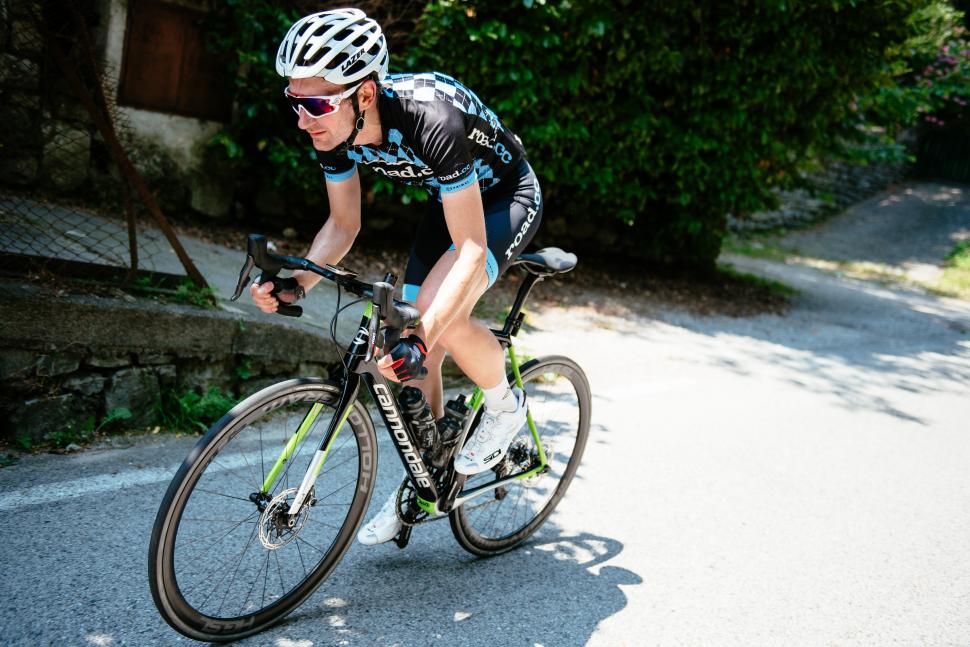
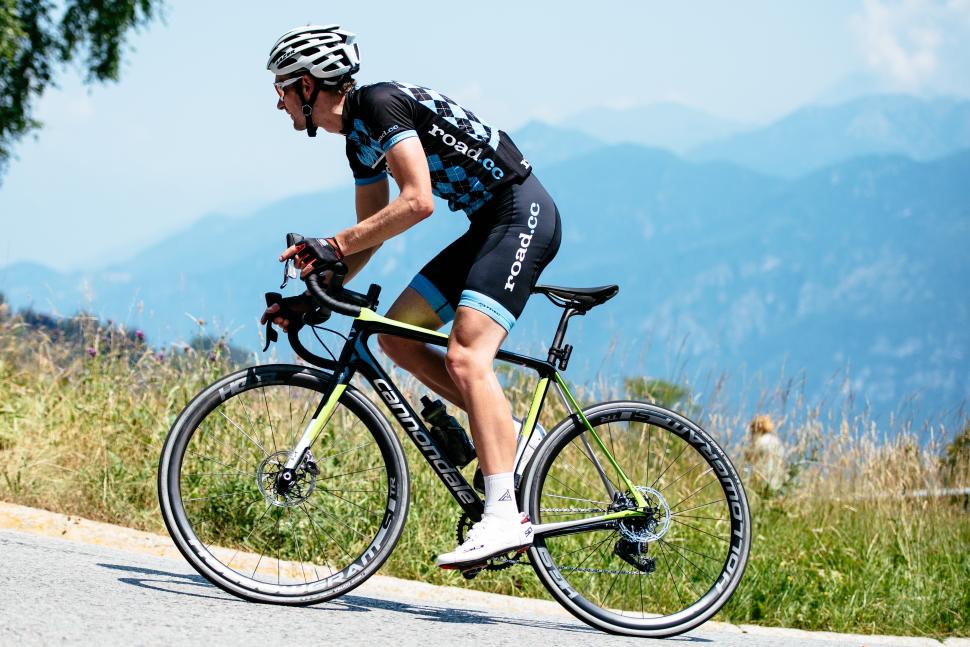
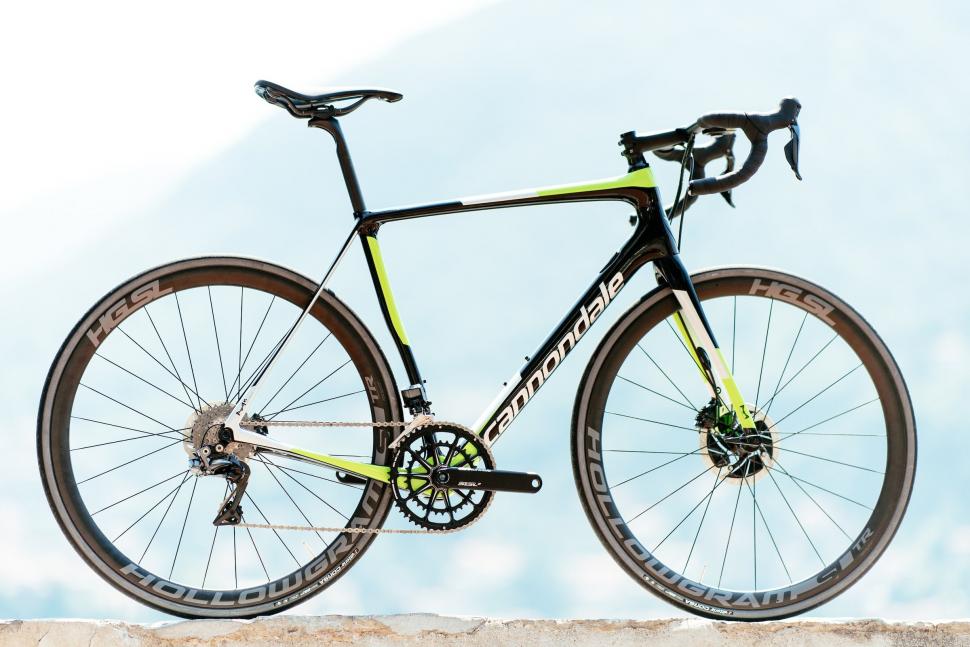

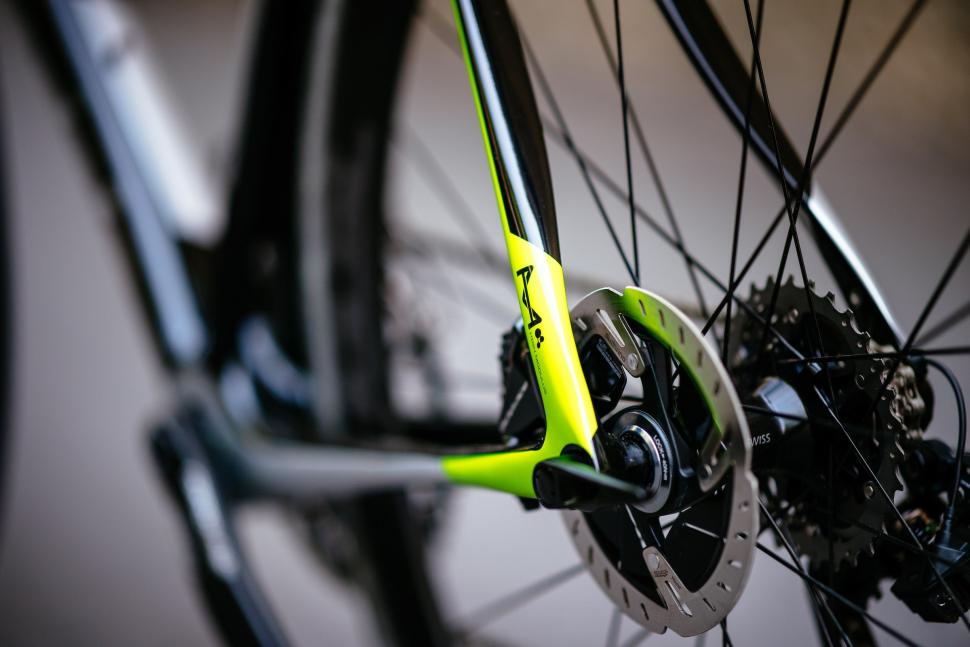
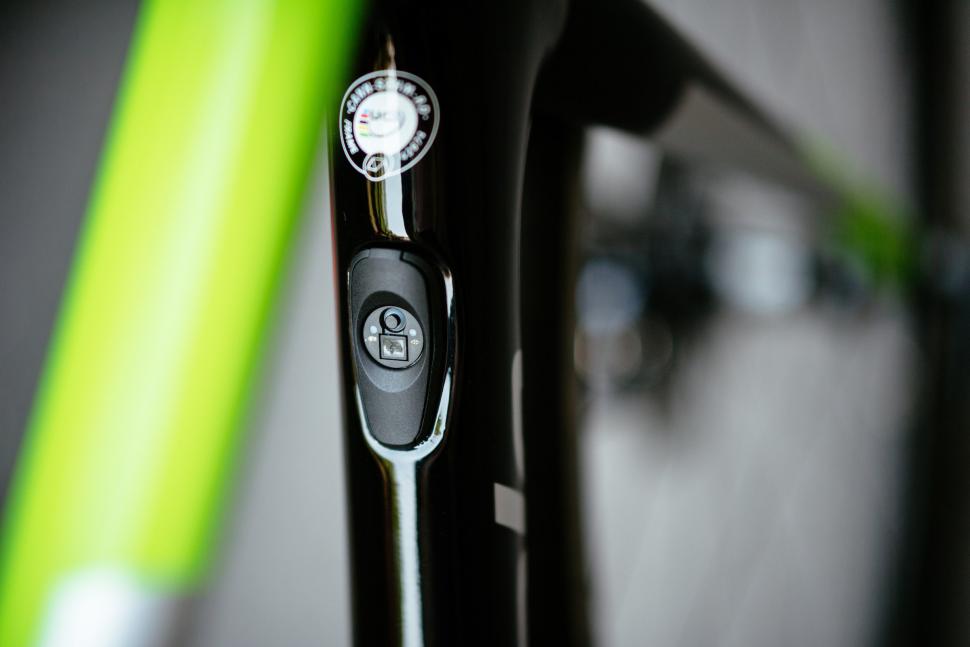
Add new comment
25 comments
You'd have to get eTap or Di2, the cable entry point on the downtube is a horror!
..and this is a £400 increase yoy on the base model!!
Is it?
https://www.evanscycles.com/cannondale-synapse-carbon-105-5-disc-2017-ro...
Same RRP as last year as someone else has pointed out. And the new carbon bike is lighter than the previous model HiMod frame.
I find most manufacturers approach to speccing new bikes cycnical especially with wheels.
Really puts me off those brands.
I hear you that many brands spec an own brand wheel to save money but Cannondale have made a great wheel here, just over 1400 grams and tubeless ready which quite a few wheels suppliers have been slow to adopt. I did two stages of Grinduro on last weekend on the Synapse with these wheels and they handled everything. Try some maybe?
This doesn't really come out in any reviews.
They are IRO £1,000 wheelset and are very slightly lighter than the rim version ( which are around £200 cheaper - why?)
I can't see why there would be any immediate need to swap out the wheels soon after buying a Synapse.
> It was my first ride on these tyres
I put it to you that the extra "seated comfort" is almost certainly because you're using wider tyres at very low pressures. If you read bicycle reviews over the last few decades, almost all new bikes are "stiffer", "faster", "more agile", etc. The list goes on. The truth is, away from technology like brakes and gears, advances in frame design provide almost negligible benefits to the average rider. You can take any frame from the last 15 years and, with nice tyres and decent equipment, I doubt many people would be able to discern the qualities so many reviewers seem to think are so obviously evident.
Shusssssssh.....put the cat back in the bag and move away....
You make a fair point, wider tyres do contribute to extra cushioning as a result of the bigger air volume. I'm not new to wider tyres I feel I should point out... I would also disagree with your claim that advances in frame design provide almost negligible benefits to the average rider
However, my point which you seemed to have missed is that the new Synapse offers more seated comfort over the older Synapse with the same width tyres, and Cannondale has succeeded in increasing the comfort the new bike offers.
I work for Cannondale so lets get that out of the way first.
We switched to a 25.4 on the last Synapse and then introduced it on Evo and CAAD12 and then introduced a SAVE seatpost on the new bike. This post flexes for and aft a dramatic amount (up to 13mm depending on rider weight), so much so that I have to set my saddle angle realy nose down so that it levels off when seated.
The wider tyres also help of course but there is a clever amount of tech built into the bike. The new handlebar flexes around 6mm and the frame deflects around 4mm at the dropout due to the SAVE stays.
Add all that up and it creates a micro suspension system on the whole bike.
All this is fine and commendable, but it is the tyres that absorb most vibration and impact from the road. Try running the bike with solid rubber tyres (like a Model T Ford) to see how effective your suspension system is. You won't last a mile.
The seat and chain stays look incredibly thin in places, especially with the paint job they've given them. I'm glad to see not all endurance bikes are going down the sit up and beg with suspension route, I guess the arrival of gravel bikes might be pushing them to a little more of the racy end of the spectrum again.
Looks good. Really good. But, and Cannondale aren't alone, stock wheels.
The 105 looks good at £2199. Indeed, that's actually the same as last year's model (yay).
But those wheels have to go. So factor in another £300 or so.
Yes, that applies to many bikes, from lots of makers. It would be nice to see them cost £100 more and be better specced.
The identically priced Endurace CF SL 9.0 is great in that respect. Nothing to upgrade.
These are the same wheels that came on the 105 spec CAAD Optimo I bought earlier this year as a new training/commuter bike. And my thoughts even in that case were, they have to go!
Would be very disappointed with them on the carbon synapse at twice the price.
Consumer direct brands can be better value on some models as they are not keeping an industry of bicycle retailers in business. However I bet if you wanted to upgrade the wheels at point of purchase you would find a dealer who would happily fit whatever you wanted and at a very reasonable price, maybe even for free.
Remember that the RRP is only a recomended price and I have seen pretty much all year dealers offering free parts with a new bike or strong discounts on all bike brands.
Yes, we're all aware of that I believe. But my point is that at £2199 most consumers would be happier paying £2299 for something better. To be fair, others are speccing Fulcrum 5's at the £2k mark (and less) which are a better wheel than the Dale ones. So it can be done.
I just looked at 2018 Trek Domane and Spesh Roubaix and they both have similar wheels although the Bontys are tubeless compatible but the bike is £300 more. The Spesh is the same price but has mechanical discs so I thnk this bke stacks up well in terms of spec. I will feed it back to the product managers that you guys would pay a little more for better wheels. Cheers.
Good man Gossa. I have to say, the others are worse. Dale tend to produce better value in terms of groupsets etc at similar price points. The other pair wind me up a bit more.
I have three Dales so I'm pretty neutral on it but I think that stuff like the SuperX would really benefit from coming with something better initialy (even the Fulcrum DB for example). Mine came with Maddux 2.0 which were strong but heavy. My Supersix was much better, coming with Aksium, making them perfectly usable in the interim. And my CAADX, Maddux again, but at £1k I couldn't really complain. Given the choice out there in the disc market it would be good to see that spec raised a bit.
The cost of some of the bikes is really in the frames though, if you compare some of our frames to custom build brands (most of which are made in the same factories) then you can often get a complete 'Dale for the price of a frameset but I am with you that it would be better to have a nicer wheel for a small upcharge. I've already emailed our product team today about it. Thanks for buying some of our bikes anyway, my kids can have new school shoes necxt term! LOL!
"Before I go on, I have an omission to make."
So what are you omitting, then? Does anyone proof read this stuff, or is the spell checker enuff?
Yeah sorry about that. You can have your money back if you want?
well, that escalated quickly.
Dave did have an omission to make: the word admission. Nothing to see here...
Not unless they come up with some much better colour schemes they haven't....